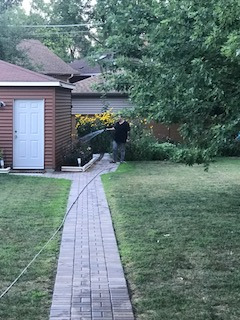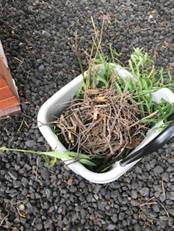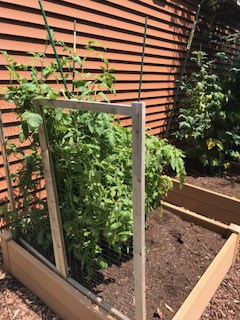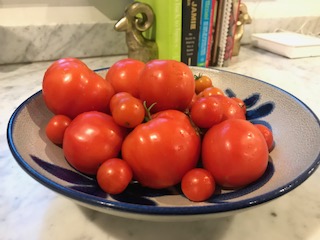Putting Your Garden to Bed
- Gillian Wineman, Deputy Director

- Oct 24, 2018
- 5 min read
Updated: Oct 12, 2022
This past July, my husband and I moved from our worker’s cottage home in Chicago to a mid-century home in Riverside, IL. With the move, we quintupled the size of our landscape, inheriting a beautiful, well-kept garden. The garden consists of plenty of low-maintenance native beds, trickier rose beds, 4 raised vegetable beds, countless planter boxes, a quarter acre of grass, shrubs and trees lining the fence, and an apple tree.
With little gardening experience, we were both quite fearful going into the move. Never mind the house, we didn’t want to screw up the pristine yard (or let our 2 huskies screw it up for us)! Lucky for us, the hard work for the year was done by the previous homeowners. So our plan for the rest of the year was to simply maintain through regular watering, weeding and mowing, and in the meantime, learn how to properly put this garden to bed for winter. Then, we’ll just learn the spring tasks over the winter—easy!
This past September, I jumped on the opportunity to staff the Putting Your Garden to Bed seminar presented by Amanda Thomsen, landscape designer, horticulturist, and author. The timing for this seminar was perfect for our plan and hopefully for many other gardeners, new or experienced, throughout Chicagoland.
I came equipped to take notes during the presentation, not wanting to miss a beat. Information offered online can be quite difficult to sift through. I’d rather hear it straight from the expert and pipe in with my questions.
I felt a sense of calm when Amanda opened the presentation with OPTION 1: DO NOTHING. As a nature lover, Amanda reminded us that nature is cyclical, and that it’s “magical” in the way gardens can sort themselves out as long as they have a healthy and thriving base. So remember, there’s always Option 1.
Below are some other “user-friendly” tips for putting your garden to bed from Amanda’s presentation. I hope this practical approach to gardening provides you with a similar sense of calm amidst all the information (and misinformation) available to us nowadays.
1) Leaves: A Gift from Mother Nature
My husband, who is in charge of our lawn care, will love this one: skip raking and bagging leaves to end up in a landfill. Mow over leaves. This chops them up nicely and acts as a natural fertilizer for your lawn.
If you have a 3-compartment compost bin, you can also compost your leaves to later use as mulch for your plants—the longer the leaves are composted, the more nutrients they provide (7 years is magic!). You can also buy natural leaf mulch. Cover plants in the mulch 2-3 inches and rake it off in the spring. Remember, you can compost over winter.

If you have the space, you can also create your own leaf composting system with chicken wire.

Amanda chops her leaves in a garbage bin with her edger to prep them for composting.
2) Perennials
Leave perennial grasses standing, you can cut them back in March or April. Birds, butterflies, and bees use standing grasses as a food source or winter home.
Not all perennials need to be cut back from frost, but some might benefit from it. A winterized conehead capped with a layer of snow can look quite stunning.

The foliage of Bearded Iris must be cut back after first frost to eliminate borers. Or you could just grow other kinds of irises. 😉

Remove any plants that show signs of disease or fungus and throw those away (do not compost).
3) Self-Seeders
Self-seeders are a matter of preference. Amanda uses plants that self-seed everywhere for a low maintenance garden. She prefers a ton of desirable plants she can edit out/transplant rather than leave space for weeds to grow. It helps to ask yourself: do the seeds feed someone? Do you want more of that plant?
4) Roses
In early Fall, stop deadheading roses and let them form hips (seedpods). Save the deadheading and pruning for the Spring. Deadheading makes room for new growth, which we do not want to encourage this time of year. Leave the hips for winter interest.
Should we cover our roses to protect them from the winter? Using cones to cover plants essentially microwaves your plants on sunny winter days. Snow is the very best insulator so stay away from cones. Just be sure to gently dust off the snow if it weighs down your plants. Consider breathable burlap barriers instead.
5) Vegetables
Any vegetable with disease or mildew must be thrown out.
How about our tomatoes? Typically, the life cycle of tomatoes ends around the time when the temperature drops. Once you’ve decided to pull out the tomato plant, throw it all away. Do not compost tomatoes—they are disease carriers.
Side note: My husband hates tomatoes! I couldn’t possibly eat them all, or give them all away, so our compromise was fresh tomato soup. Turns out he really enjoys the taste of tomatoes, just not the consistency when eaten raw.
6) Houseplants
Now is the last chance for you to repot your houseplants outside!
Always make sure you have a plastic pot inside a decorative pot (oftentimes the decorative pots are without drainage).
Pull out the plant, tease the roots, find a slightly larger plastic pot, and drop it into the decorative pot.
Be aware that over and under watering is the trickiest part of maintaining houseplants.

7) Bulbs
Amanda recommends you plant your bulbs in November—it’s a very cheerful and easy activity with a whole lot of reward, especially for those dealing with Seasonal Affective Disorder (SAD).
Bulbs are rough and tumble. All you do is dig a hole, throw them in and put a little soil on top. Adding a little bit of chili powder helps to deter squirrels.
Try daffodils, crocus and allium. Alliums are the BEST—they keep rabbits, mice and chipmunks away. Crocuses are great along pathways.
Avoid tulips. They last a short amount of time and are very high maintenance.
When the bulbs sprout, take this as a queue to get going on your Spring cleanup!
8) Lawn

One of our huskies likes to dig holes in our yard. What should we do? Fill in the hole with soil, top-dress dirt patches with good compost and wait for grass seeding until Spring.
For preventative measures, we plan to install a sandbox with dog treats! Hopefully this will distract her from digging more holes…
Core aeration once a year will help keep your lawn growing strong and withstand cold weather stress. You can rent a core aerator machine or hire a company to do the work for you. Using a pitchfork is a more laborious option.
9) Hoses
Remember to disconnect and put away your hoses, turn your exterior spigots off, and empty your rain barrels!
10) Prepare for Snow
When it comes to ice melting products, consider using a calcium chloride instead of sodium chloride. Sodium chloride kills plants.
Natural burlap barriers are great for protecting trees, shrubs and plants from winter winds and snow. If you don’t use barriers, be sure to knock heavy snow off arborvitaes, etc.
11) Winter Pruning


And... remember Sweet Geraniums for next summer:
Our Executive Director got me these Sweet Geranium plants from the farmers market downtown near our office because I told her the mosquitoes were brutal over the summer with us being so close to the Des Plaines River. Turns out Sweet Geraniums are an excellent natural mosquito deterrent!

Thank you to Amanda for giving two fabulous presentations, sharing this information, and providing images for this blog!

Amanda Thomsen, Kiss My Aster www.kissmyaster.com asterkissing@gmail.com
Instagram: @kissmyaster Twitter: @kissmyaster Facebook: @kissmyasterblog




































Comments